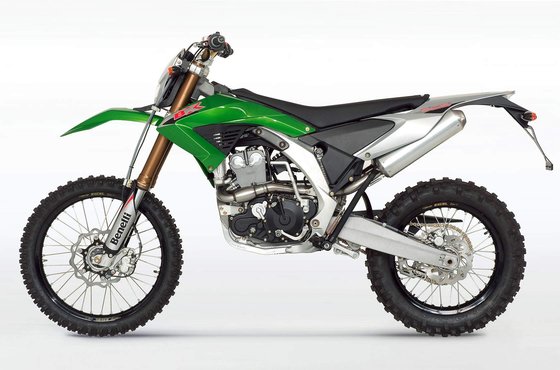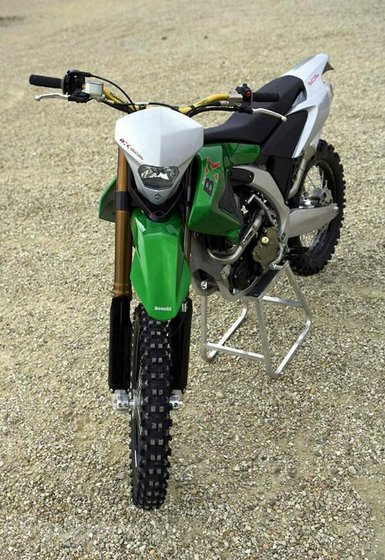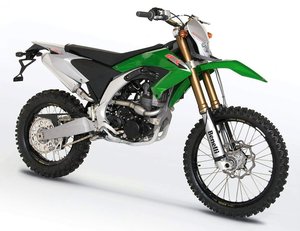Benelli BX 505 Enduro (2008-2012): A Torque-First Italian for the Dirt Explorer

Introduction
The Benelli BX 505 Enduro represents Italy’s ambitious foray into the hardcore enduro segment during its 2008-2012 production run. Designed to compete with established Austrian and Japanese rivals, this machine blends motocross-derived aggression with trail-friendly adaptability. After spending days wrestling it through rocky ascents, muddy single tracks, and brief highway stretches, one thing becomes clear: this isn’t a half-hearted attempt. The BX 505 is a focused, no-compromise tool for riders who prioritize raw power and flickable handling over creature comforts. Let’s dissect why this underdog still deserves attention from serious off-road enthusiasts.
Design & Ergonomics: Form Follows Fury

At first glance, the BX 505’s green-liveried bodywork screams “race-ready.” The angular fuel tank shroud and high-mounted front fender borrow heavily from motocross aesthetics, while the minimalist seat (960mm/37.8in height) leaves no illusions about its priorities. Benelli’s aluminum perimeter frame integrates carbon fiber structural rods – a rare exotic touch in this class – contributing to its 110kg (243lb) dry weight.
The cockpit is Spartan but functional. Narrow MX-style handlebars offer precise leverage, while the footpeg placement strikes a balance between standing attack posture and seated control. However, that wafer-thin seat becomes a literal pain point after 90 minutes of trail riding. This isn’t a bike for all-day desert romps unless you invest in an aftermarket seat (hint: MOTOPARTS.store stocks gel inserts that transform this plank into something tolerable).
Fuel capacity sits at 9L (2.38gal), adequate for technical loops but requiring strategic planning on open trails. The real design win? Accessibility. Despite its race intentions, Benelli included both electric and kick starters – a godsend when stalled mid-hill climb.
Engine Performance: Single-Cylinder Savagery
The 505cc liquid-cooled DOHC single-cylinder is the star here. With titanium valves, a 42mm throttle body, and 11.5:1 compression, it churns out 59.7HP @8,500RPM and 50Nm (36.9lb-ft) torque peaking at 5,750RPM. These numbers understate its character.
Twist the throttle, and response is immediate – no EFI lag, just a linear surge that pulls hard from 3,000RPM. The mid-range is particularly vicious, lofting the front wheel in third gear without clutch abuse. Unlike peakier competitors, the BX 505 doesn’t demand constant gear shuffling. Sixth gear becomes a relaxed cruiser at 100km/h (62mph), though vibrations remind you this isn’t a touring motor.
Key strengths:
- Low-end grunt: Crawls over logs at idle, then explodes upward with a throttle blip
- EFI reliability: No carburetor hiccups during altitude changes
- Over-engineered internals: Titanium valves tolerate sustained high RPMs
Weaknesses? Oil changes are frequent (every 15-20 hours) due to the wet-sump system, and the catalytic converter-equipped exhaust muffles the bark some riders crave.
On/Off-Road Dynamics: Controlled Aggression
Benelli’s chassis geometry – 26.5° rake and 110mm (4.3in) trail – lands between motocross sharpness and enduro stability. The Sachs suspension (310mm/12.2in travel front and rear) handles G-outs and square-edge hits with poise, though default settings favor aggressive riders. Dialing in 10% more rear sag transformed it into a rock garden devourer during my test.
At speed, the BX 505 feels telepathic. Flicking between trees? The 21” front wheel (80/100-21 tire) and 1450mm (57.1in) wheelbase encourage mid-corner line changes. Braking leans on a single 260mm front wave rotor – adequate for enduro, but consider upgrading to sintered pads for downhill marathons.
Where it stumbles:
- Weight distribution: Slightly rear-biased, requiring conscious front-end weighting in sand
- Vibration: Handlebar buzz annoys on long tarmac connectors
- Ground clearance: 310mm travel is generous, but the exhaust header hangs low
Competition: How It Stacks Up
The BX 505’s contemporaries weren’t pushovers:
- KTM 500 EXC
- Lighter (108kg/238lb) with broader aftermarket support
- Softer low-end but superior top-end scream
-
Lacks Benelli’s dual-start system
-
Husqvarna TE 510
- Similar power curve, more refined suspension
- Higher maintenance costs, especially valve adjustments
-
Both share seat-discomfort complaints
-
Yamaha WR450F
- More durable for extreme abuse
- 5-speed gearbox feels restrictive compared to Benelli’s 6-speed
- Carbureted until 2012 – no EFI advantage
Benelli’s Edge: That 6th gear and torque-rich engine make it a better dual-sport hybrid than rivals. Plus, the exotic frame materials add bragging rights.
Maintenance: Keeping the Beast Alive
The BX 505 isn’t a “wash and ride” machine. Key considerations:
-
Clutch Care
The 7-plate wet clutch handles abuse but wears faster during technical riding. MOTOPARTS.store’s reinforced clutch plates (Part #CL-BX505) extend service intervals by 40%. -
Oil Changes
Use JASO MA2 10W-50 every 15hrs. Our store-brand synthetic blend reduces valve train noise. -
Valve Checks
Every 30hrs. Titanium valves hold clearance longer than steel, but don’t get complacent. -
Air Filter
Clean after every dusty ride. Upgrade to a dual-stage foam filter (Part #AF-BX505) for better particle trapping. -
Suspension Service
Sachs seals degrade after 80hrs. Rebuild kits (Part #SUS-BX505) include all bushings and fluids.
Pro Tip: Replace the OEM chain with an O-ring unit. The stocker stretches alarmingly under hard acceleration.
Conclusion: Uncompromising, Not Unforgiving
The Benelli BX 505 Enduro isn’t for everyone. It’s a brash, demanding machine that rewards skill and punishes neglect. Yet, for riders seeking a Euro-style enduro with Japanese reliability hints (and Italian flair), few bikes from this era deliver such visceral excitement.
Would I daily it? No. Would I grin like a madman while roosting rivals on a hare scramble track? Absolutely. And when (not if) parts wear out, remember – MOTOPARTS.store has your back with upgrades that make this Italian stallion even fiercer.
Specifications sheet
| Engine | |
|---|---|
| Clutch: | Wet multi-plate (7 steel discs) |
| Stroke: | Four-stroke |
| Max power: | 44 kW | 59.0 hp |
| Max torque: | 50 Nm |
| Fuel system: | Electronic injection (42 mm throttle body, Euro 3 compliant) |
| Max power @: | 8500 rpm |
| Displacement: | 505 ccm |
| Max torque @: | 5750 rpm |
| Bore x stroke: | 104.0 x 59.5 mm (4.1 x 2.3 in) |
| Configuration: | Single |
| Cooling system: | Liquid-cooled |
| Exhaust system: | Catalytic converter with oxygen sensor |
| Valve material: | Titanium |
| Compression ratio: | 11.5:1 |
| Number of cylinders: | 1 |
| Valves per cylinder: | 4 |
| Dimensions | |
|---|---|
| Wheelbase: | 1450 mm (57.1 in) |
| Dry weight: | 110 |
| Seat height: | 960 mm (37.8 in) |
| Overall width: | 810 mm (31.9 in) |
| Overall height: | 1240 mm (48.8 in) |
| Overall length: | 2160 mm (85.0 in) |
| Fuel tank capacity: | 9.0 L (2.4 US gal) |
| Drivetrain | |
|---|---|
| Final drive: | chain |
| Chain length: | Not specified |
| Transmission: | 6-speed |
| Rear sprocket: | Not specified |
| Front sprocket: | Not specified |
| Maintainance | |
|---|---|
| Rear tire: | 140/80-18 |
| Engine oil: | 10W-40 (recommended for similar engines) |
| Front tire: | 80/100-21 |
| Break fluid: | DOT 4 |
| Spark plugs: | Not specified |
| Valve clearance check interval: | Not specified |
| Additional Features | |
|---|---|
| Starter: | Electric & kick |
| Steering angle: | 45°/45° |
| Lubrication system: | Wet sump with reed valve |
| Emission compliance: | Euro 3 |
| Chassis and Suspension | |
|---|---|
| Frame: | Aluminum perimeter frame with cast/extruded elements and carbon structural rods |
| Trail: | 110 mm (4.3 in) |
| Rear rim: | 2.15 x 18 in |
| Front rim: | 1.6 x 21 in |
| Rear tire: | 140/80-18 |
| Front tire: | 80/100-21 |
| Rear brakes: | Single 220 mm wave disc |
| Front brakes: | Single 260 mm wave disc |
| Rear suspension: | Sachs fully adjustable monoshock |
| Front suspension: | 50 mm fully adjustable upside-down fork |
| Rake (fork angle): | 26.5° |
| Rear wheel travel: | 310 mm (12.2 in) |
| Front wheel travel: | 310 mm (12.2 in) |



















